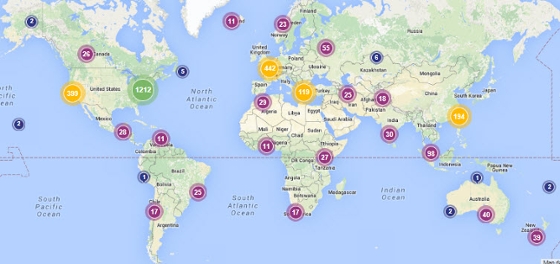JMU Scholarly Commons
Graduate School
Graduate Scholarship Reaches Global Audience
Story written by: Alyse Scicluna Lehrke, M.A. Communication, Candidate for Ph.D. in Strategic Leadership Studies
It’s a normal morning in Harrisonburg, Virginia, the home of James Madison University, but late at night, around the world in Hong Kong, someone is downloading the thesis of a JMU graduate student through JMU Scholarly Commons. Through this digital repository, research by JMU students and faculty is having a global impact. Researchers from all over the world can discover and retrieve JMU scholarship through major search engines like Google, Bing, and Yahoo as well as direct database and library searches.
Launched in the fall of 2014, JMU Scholarly Commons originated with the strong need to make scholarship discoverable, according to Laura Drake Davis, JMU’s Digital Collections Librarian. With more than 6,000 items currently in the database and more being added all the time, this open access publishing platform provides a way for JMU students and faculty to reach a larger audience with their work. The readership map on the JMU Scholarly Commons page shows what content is accessed, when, and where in the world. To date, over 190,000 items have been downloaded from every continent except Antarctica. Authors even receive a report to let them know how many times their content has been accessed and where.
JMU is one of 460 institutions that currently make up the Digital Commons Network with a collective two million items easily discovered on the web. In addition to tracking downloads for individual items, the Digital Commons platform ranks institutions in the network based on popular trends in research topics. For instance, JMU is currently ranked third in social media research. Research divisions like Communication Sciences and Disorders and Statistical Methodology receive a high number of downloads as well, putting JMU in the top institutions for these areas.
JMU Scholarly Commons provides a place for capturing and showcasing outstanding student and faculty scholarship with a high level of accessibility. Projects like theses and dissertations, Honors Symposium items and Honors projects, Graduate Showcase selections, and JMU conference proceedings are automatically added to the Scholarly Commons collection. Plus, individual authors can submit their work by simply creating an account and completing the submission form. When work is submitted, key words are attached along with other search engine optimization options so it can be indexed in Google Scholar and crawled by major search engines.
Making JMU scholarship widely available has benefits for the author and the reader. Laura Ryman, Director of Graduate Student Support, explained how theses and dissertations were previously archived on the shelves of the university library, making it difficult to find and access the work. These theses and dissertations are no longer collecting dust in the library. Thanks to JMU Scholarly Commons, they are easily accessed from anywhere in the world, increasing the visibility and citations of the author and helping readers find relevant work for continued research. In addition to scholarly works, some JMU Special Collections content is also available in JMU Scholarly Commons including The Breeze, yearbooks, and other archived works.
As a new distribution model for making scholarship available to wider audiences, JMU Scholarly Commons is creating exciting opportunities for graduate students to publish their work. The repository is also being used by educators to access scholarship and other resources that can easily be available for classroom work and learning experiences. As JMU Scholarly Commons continues to grow and its utility changes, librarian Laura Drake Davis emphasized the importance of creating positive experiences for individuals accessing materials as well as the authors publishing their work. The way scholarly content is published and accessed continues to evolve, and graduate students can take advantage of the new opportunities for sharing their work. JMU Scholarly Commons is literally putting the work of JMU students and faculty on the world map.

